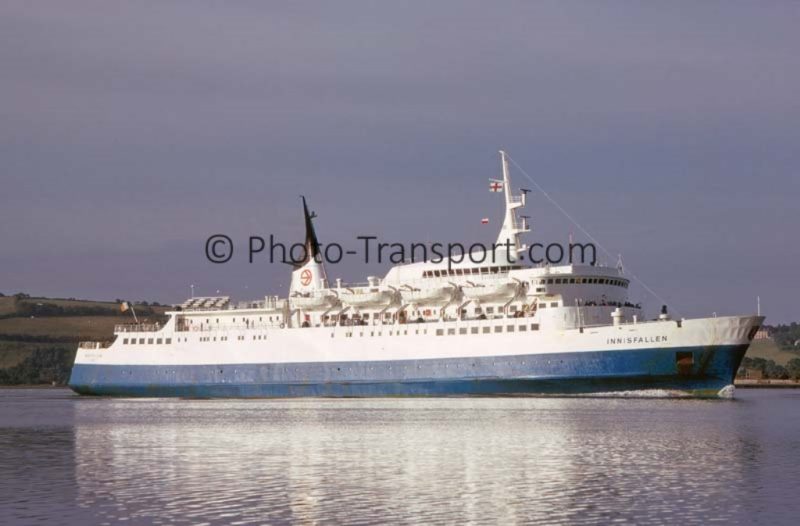
This article is a celebration of over two hundred years of passenger shipping to Éire, and deals with the many coastal passenger ships and passenger ferries that operated the links between Southern Ireland and England and France. Several other Irish shipping companies are mentioned other than the leading players of the British & Irish Steam Packet Company (B. + I.) from 1836 to 1995 and Irish Ferries Ltd. from 1995 to the present day. The passenger services from Southern Irish ports to Southern Welsh ports are included only for these two companies, as there were other companies including nationalised rail companies that were not Irish owned, nor is the Stena Line service from Rosslare to Cherbourg for the same reason.
A regular service had operated between Dublin and London for a decade or more years before the B. + I. was formed on the Eden Quay in Dublin in 1836.
The wooden paddle steamer Thames of 70 grt had first achieved an amazing voyage in 1815 from Dublin to London, with travellers arriving by sea at Dublin at this time disembarking on the South Wall at the Pigeon House Hotel, opened in 1793 near the Pigeon House Fort opened in 1814 for military use. The long main channel extended four miles eastward to end with the life saving beams of the Poolbeg Light House at the end of the South Wall and opened in 1768 using candle power, but changed to oil power in 1786.
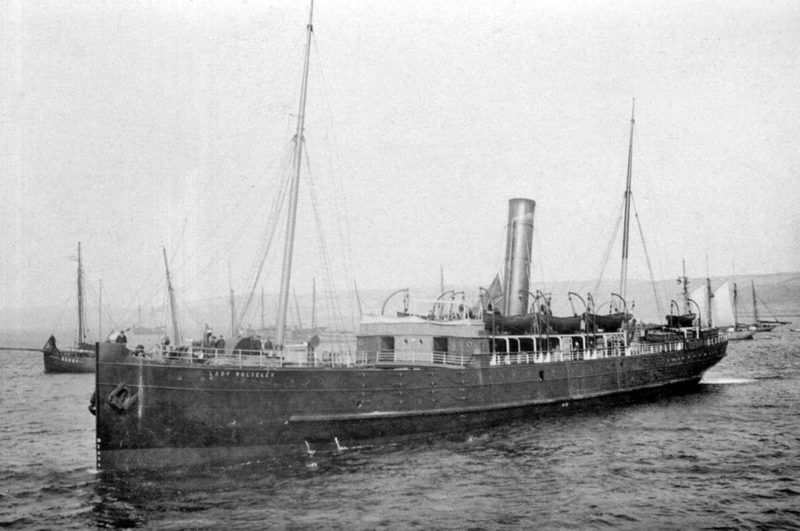
FORMATION OF B. + I.
B. + I. was formed on 27th July 1836 when a group of Dublin businessmen including Arthur Guinness of the Irish beer family, James Ferrier of the Transatlantic Steam Ship Company, Richard Williams and James Jameson met, with Articles of Association signed on 24th October 1836 for a company with a capital of £100,000 divided into £20 shares, with many of these owned by the Guinness family. The B. + I. worked closely with the City of Dublin Steam Packet Company, formed in 1823, for most of its existence to 1924, with one of their directors, Frank Carleton, also on the B. + I. Board. Three wooden paddle steamers formed the entire fleet at first, these being Devonshire, Shannon and City of Limerick, but a rapid increase in passenger numbers became apparent, and in 1842 the Duke of Cornwall was completed for the company. Two schooner rigged passenger screw steamers, Shamrock and Rose, marked another important milestone for the company in 1845.
B. + I. purchased its first iron screw steamer Foyle in 1850 and was one of the finest passenger vessels afloat at the time. The steamers Lady Eglinton and Nile were added during 1852/53 with two of these excellent ships chartered for the long voyage to the Black Sea and service in the Crimean War between 1853 and 1856. B. + I. took up residence on the North Wall in 1860, and ran a short lived service between Dublin and Waterford for the next three years. The shipyard of Walpole, Webb and Bewley built the larger passenger steamer Lady Wodehouse of 843 grt for the Dublin to London service, followed by the Countess of Dublin of 760 grt from the same yard in 1869, both giving long service until the mid 1890s.
B.+ I. increased its capital by £20,000 in 1878 and made the company into one of limited liability, having taken over the Waterford Steam Ship Company and its two steamers on the London service in 1870. An order with the A. & J. Inglis yard at Pointhouse on the Clyde was completed as Lady Olive of 1,013 grt in 1878 as the last iron hulled screw steamer for the company, and she gave 32 years of service to the company before being sold to Greek owners. The advantages of steel hulls and the triple expansion steam reciprocating engine were used to good effect on the Dublin to Falmouth, Torquay, Southampton, Portsmouth and London route in five prestigious and splendid passenger steamers completed between 1888 and 1911 as:-
Lady Martin of 1,356 grt from the Workman, Clark & Co. Ltd. yard in Belfast and launched in 1888
Lady Hudson-Kinahan of 1,368 grt from the Ailsa yard at Troon and launched in 1891
Lady Wolseley of 1,450 grt from the Naval Construction and Armaments Company at Barrow and launched in 1894
Lady Roberts of 1,462 grt from the Ailsa yard at Troon and launched in 1896
Lady Gwendoline of 2,163 grt from the yard of the Clyde Shipbuilding Co. Ltd. at Port Glasgow and launched on 13th May 1911.
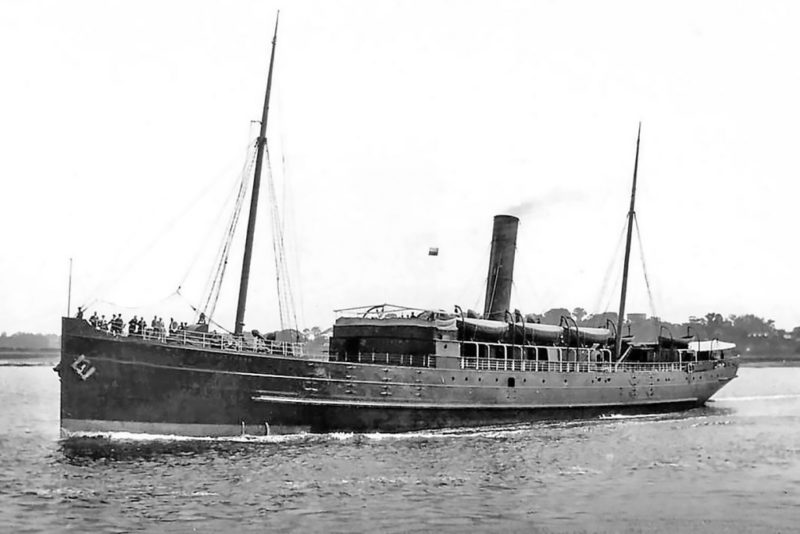
The overall dimensions of the first four were length of between 270.0 and 275.0 feet, moulded beam of 36.0 feet, and moulded depth of 16.5 feet, while Lady Gwendoline was larger at overall length of 300.2 feet, moulded beam of 39.7 feet, and moulded depth of 17.5 feet. Triple expansion steam reciprocating engines, mostly by the shipbuilders, gave a good turn of speed of 13 knots. They had excellent passenger accommodation for 100 passengers in First Class, 50 in Second Class on the upper decks as well as steerage accommodation down below, with well equipped staterooms with bathrooms, and saloons and smoking rooms. The accommodation was so grand that B. + I. offered weekend cruises on these passenger steamers from Dublin to Falmouth and Plymouth to enjoy the pleasures of these Cornish and Devonshire cities, with singing and entertainment laid on in the form of a grand piano played by a professional pianist. The spaciousness, comfort and speed of these B. + I. steamers made them firm favourites with the travelling public between Dublin and London.
The ‘Lady’ boats had such a good turn of speed and could show a ‘clean pair of heels’ to chasing U boats during World War I. Several passenger ‘Lady’ steamers were chased and attacked by gunfire but escaped due to their speed. Lady Roberts and Lady Hudson-Kinahan were sold in 1914 to Italian and Greek owners and renamed Sassari and Elsie respectively, with Lady Martin sold to Turkish buyers at the beginning of the war, but was seized at Glasgow before delivery following the Turkish entry into the war on the German side. She came back into the B. + I. fleet before being sold again to Cunningham, Shaw & Company and renamed as Purfleet Belle.
Lady Wolseley was chased and attacked by gunfire on 18th August 1915 by a U boat when 55 miles from the Longships Light House, but escaped due to her superior speed. She was sold later that year to the Limerick Steamship Co. Ltd. of Limerick and renamed Kinvarra, and then to Lord Armstrong of Newcastle and Rothbury in Northumberland, inventor of the marine steam turbine, and renamed River Tyne, but she foundered on 25th October 1916 when 30 miles off Oporto in Portugal. Lady Gwendoline was missed by a torpedo fired in the North Sea on 29th July 1918, having been requisitioned for Russian service to Archangel during 1917/18. She did not return to B. + I. service after the war, but was sold for further service with the Dundee, Perth & London Shipping Co. Ltd., C. T. Bowring, Furness Withy & Co. Ltd. and several other owners before finally being broken up in China in 1952.
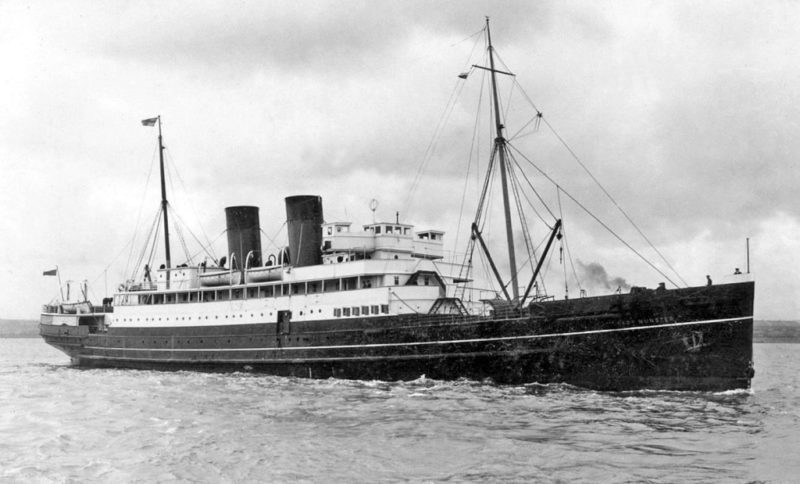
Lady Cloe of 1,582 grt was one of two new ships completed for the company during the war in 1915/16 with accommodation for one hundred First Class passengers, the other being her sister Lady Wimborne. They were completed by the Sir Raylton Dixon yard at Middlesbrough and the Clyde Shipbuilding Co. Ltd. at Port Glasgow with dimensions of overall length of 260.2 feet, moulded beam of 38.2 feet, and moulded depth of 14.6 feet, with a fo’c’stle of length 33.0 feet and a bridge deck of length 88.0 feet. They had one complete steel deck and one shelter deck, with 504 tonnes of water ballast carried in deep tanks, fore peak and aft peak. Lady Cloe was chased by a U boat in the English Channel on 4th September 1917 but escaped due to her superior speed. Lady Tennant of 452 grt and completed on the Clyde in 1904 was attacked twice in a thirty day period in February and March 1918 by torpedo in the Bristol Channel and Irish Sea and was towed into port and repaired. She was under Langlands ownership at this time, which was absorbed by Coast Lines in 1919, and was transferred to B. + I. ownership in 1920 and then to Coast Lines in 1924 as Elgin Coast, before coming back to B. + I. as Kilkenny in 1930. She was broken up in Greece in March 1974 after a career of 70 years, after being sold for further service to German and then Greek owners in 1936.
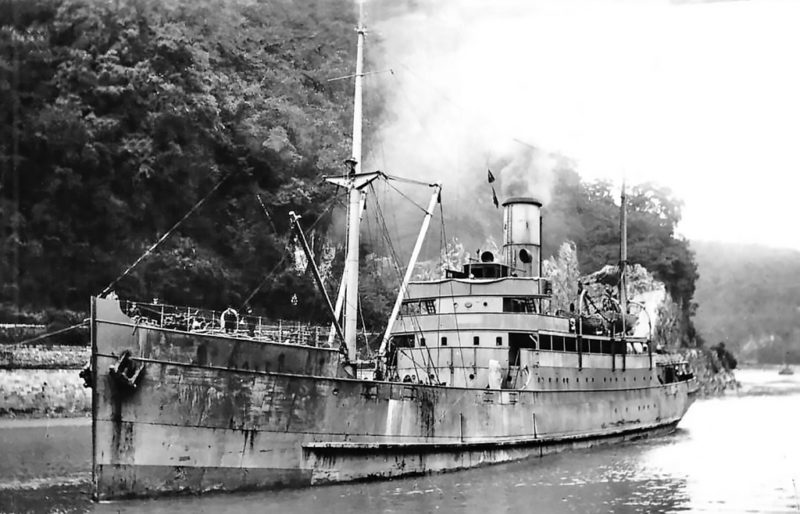
ROYAL MAIL LINE ACQUISITION OF B. + I.
The major shareholder of B. + I. in 1914 was Furness, Withy & Co. Ltd. of London, set up in 1891 by Sir Christopher Furness at West Hartlepool. Sir Alfred Read of the amalgamated Coast Lines group formed from the Powell, Bacon & Hough Lines Ltd. in 1913 had already purchased 534 shares of £50 each in B. + I. in 1914. Royal Mail Line then acquired Coast Lines in March 1917 for £800,000 with Sir Owen Philipps (later Lord Kylsant) issuing £1 million of Royal Mail Line shares. Royal Mail Line planned to use the coastal feeder network of Coast Lines for their deep sea ships and trades. After the Royal Mail Line acquisition of Coast Lines, the latter purchased all of the non-Furness, Withy & Co. Ltd. shares in B. + I. to give a controlling interest, and by mid 1917 the Furness, Withy & Co. Ltd. shares were also bought, giving full control. The ‘Lady’ passenger boats with green funnels and black tops, with a white central band added in 1937, were now owned by Coast Lines with parent company of Royal Mail Line, and thus were British owned.
A controlling interest was also purchased for B. + I. Line in the City of Dublin Steam Packet Company and the City of Cork Steam Packet Company in 1918/19. The Dublin company dated from 1823 and had been left at the end of the war with only five coasters and two mail steamers, Munster and Ulster, out of a quartet of twin funnelled express passenger ships built in 1896/97 by the Laird yard at Birkenhead, and named after the four provinces of Ireland. The other pair, Connaught and Leinster, had become war losses. The City of Dublin Steam Packet Company was on the verge of liquidation when the take-over occurred, and withdrew their Dublin to Liverpool sailings in 1919, which were merged into the B. + I. The virtual end of the City of Dublin Steam Packet Company occurred when it lost the twice daily Holyhead to Kingstown (Dun Laoghaire) mail contract to the London & North Western Railway Company in November 1920, and the company went into liquidation in 1924.
The City of Cork Steam Packet Company was a descendant of the famous St. George’s Steam Packet Company, formed in 1821 for Liverpool to Glasgow passenger services, and also later out of Hull. It was not merged into the B. + I. until 1936 and its ships retained their white funnels with black tops. A small Irish company was also taken over in 1919 in the Dublin based Tedcastle, McCormick & Co. Ltd. owning five coal carrying coasters, with the cargo only coasters Belfast, Blackrock, Cumbria, Dublin and Eblana then transferred to the B. + I.
The capital of the B. + I. was increased to £2.5 million in 1919, and rationalisation of the Dublin to London service had followed their take-over by Coast Lines. Lady Wicklow of 1,032 grt and completed in 1895 and Lady Louth of 1,229 grt and completed in 1894 were the only two ships of the ten acquired from the City of Dublin Steam Packet Co. Ltd. and Tedcastle, McCormick & Co. Ltd. to give long service to B. + I. on the Irish Sea during the inter-war years.
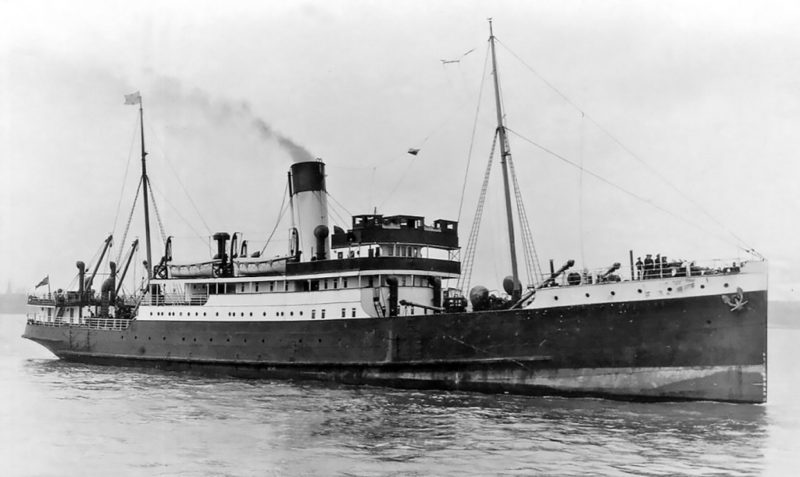
The Chairman of B. + I. Line in 1920 was thus Sir Owen Philipps, and Managing Director and Acting Chairman in Sir Alfred Read, and other directors included Lord Pirrie of Harland & Wolff Ltd., and Capt. A. R. Stansmore Nutting, Deputy Chairman of Coast Lines, as well as George N. Jacobs. The General Manager was David Barry at Sir John Rogerson’s Quay in Dublin, with Sir Alfred Read having plans for a new Dublin to Liverpool nightly express passenger service. B. + I. had a fleet of 18 steamers in 1920 on its services from Dublin to London via South Coast ports, and to Liverpool, Manchester and Belfast from Dublin. The telegraphic address of B. + I. was ‘Ladyships’, and the loading berths in Dublin were at the North Wall and Sir John Rogerson’s Quay. The fleet included thirteen ‘Lady’ boats in 1920 as follows:-
Lady Carlow of 1,200 grt completed in 1896 by Blackwood & Gordon at Port Glasgow
Lady Cloe of 1,582 grt completed in 1916 by Sir Raylton Dixon at Middlesbrough
Lady Emerald of 1,389 grt completed in 1919 by the Caledon yard at Dundee
Lady Kerry of 1,200 grt completed in 1897 by Blackwwod & Gordon at Port Glasgow
Lady Kildare of 1,216 grt completed in 1920 by the Beardmore yard at Dalmuir
Lady Killiney of 1,145 grt completed in 1918 by the Caledon yard at Dundee
Lady Louth of 1,229 grt completed in 1894 by the Blackwood & Gordon yard at Port Glasgow
Lady Martin (2) of 1,188 grt completed in 1913 by the Sir Raylton Dixon yard at Middlesbrough
Lady Meath of 956 grt completed in 1906 by Scott’s of Greenock
Lady Patricia of 1,391 grt completed in 1919 by the Caledon yard at Dundee
Lady Tennant of 452 grt completed in 1904 by Napier & Miller Ltd. at Glasgow
Lady Wicklow of 1,174 grt completed in 1895 by Blackwood & Gordon at Port Glasgow
Lady Wimborne of 1,542 grt completed in 1915 by the Clyde Shipbuilding Company at Port Glasgow
In 1923, two new express passenger liners were delivered by the Ardrossan Dockyard as the sisters Lady Louth and Lady Limerick of 1,870 grt for the new night service between Dublin and Liverpool with accommodation for 80 First Class and 90 steerage passengers, as well as cattle in the holds, with sailings at fixed times instead of with the tide. A third passenger ship on this route was Lady Longford, built as Ardmore in 1921 for the City of Cork Steam Packet Co. Ltd. Lady Louth also went cruising on 14th September 1924 on a twelve day cruise to the Scottish Western Coasts. The twin funnelled Lady Brussels of 1,090 grt and built in 1901 had been purchased two years earlier in 1922 for the service to Preston from Dublin, and had achieved fame on 23rd June 1916 when she was captured off the Hook of Holland, and her heroic Master, Capt. Fryatt, then attempted to ram the U boat, and he was later executed by German firing squad.
On 28th October 1926, the B. + I. took full control of the Dundalk & Newry Steam Packet Co. Ltd., with four steamers, but three were immediately sold for breaking up, and only the steamer Iveagh of 598 grt completed in 1892 by the Inglis yard was retained and renamed as Lady Iveagh. Michael Murphy Ltd., a Dublin based firm was also taken over in 1926 and merged into the B. + I. along with the Murphy owned Dublin General Steam Shipping Co. Ltd. Michael Murphy had founded both firms in Dublin in the 1870s, and he built five of his steamers at the Liffey Dockyard and was Chairman of the Dublin Port and Docks Board in 1903, but had died shortly before the sale of his fleet, with only two coasters remaining.
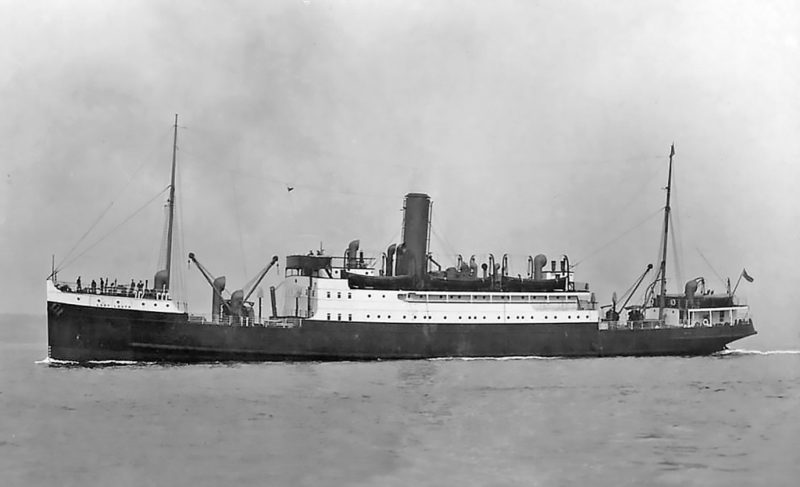
On 17th May 1929, two former ships of the Belfast Steamship Co. Ltd., also a member of the Coast Lines Group, originally named Comic and Logic, came to the B. & I. as Lady Kerry (2) and Lady Carlow (2) on the cessation of their Belfast to Ayr service, In 1930, a trio of Belfast Steamship Co. Ltd. ships originally named Graphic of 1,871 grt, Heroic of 1,869 grt and Patriotic of 2,254 grt, with greater passenger accommodation, that had been displaced by new motor passenger liners, were transferred to the Dublin to Liverpool service of the B. + I. as Lady Munster, Lady Connaught and Lady Leinster respectively. They were refitted and reconstructed for their new role with twin motorship funnels, although they remained as steamers. The slightly larger Lady Leinster could be distinguished from her earlier consorts by her longer fo’c’stle and differed internally by having triple expansion steam engines instead of quadruple expansion steam engines in the other pair. All of the trio were given silver grey hulls, and their boat and poop decks were extended for the Dublin service.
A sad loss for the City of Cork Steam Packet Co. Ltd. in 1924 was their new ship Lismore, which disappeared on her maiden voyage from Cork, with only one survivor found among wreckage on the Wexford coast. Their passenger service on the Cork to Liverpool route was maintained from 1921 by the twin funnelled Classic of 1893, chartered from the Belfast Steamship Co. Ltd. for intervals until acquired in 1924 and renamed Killarney, serving until sold to Coast Lines for cruising in 1931, and by Kenmare built at Ardrossan in 1921 with accommodation for 195 First Class and 271 Third Class passengers, her sister Ardmore having been transferred to the B. + I. as Lady Longford shortly after completion. Kenmare served in peace time and war time for 35 years on this route until sold for breaking up in 1956 at Passage West near Cork.
Lady Meath of 1,598 grt was completed in 1929 by the Ardrossan Dockyard as a cargo vessel of 1,600 dwt. Lady Louth (3) of 1,389 grt was purchased in 1930 as Lairdsforest from Burns & Laird Lines but had been built as the Duke of Montrose by the Caledon yard at Dundee in 1906. Two very elderly vessels were purchased from the London & North Eastern Railway Company (LNER) in 1932, with one renamed as Lady Glen for a year before both were broken up in 1933 at Preston. The coaster Wexfordian of 602 grt was purchased in 1933 from the Wexford Steamship Co. Ltd. and was renamed Lady Cavan, and the last three vessels from the fleet of the City of Cork Steam Packet Co. Ltd. joined B. + I. in 1936 in the passenger ship Innisfallen of 3,071 grt built in 1930 by the Harland & Wolff yard at Belfast, and Ardmore of 1,145 grt built in 1918 at the Caledon yard, and earlier in the B. + I. fleet in 1919 as Lady Killiney until transferred to the Cork company and renamed in 1923, and in Kenmare of 1,675 grt built at Ardrossan in 1921. The B. + I. fleet in 1932 was one of 16 passenger and cargo ships, of which 14 had ‘Lady’ prefixes to their names.
One of several attempts to return B. + I. to Irish ownership over three decades was made during 1934/36. Coast Lines remained very profitable during the Depression, with profits of £359,644 during 1934, its highest figure since 1921. The collapse of parent company Royal Mail Group in 1932 made the Coast Lines directors decide to purchase two million ordinary shares in the Group, with Hambros Bank handling the transaction. One of two conditions imposed on the purchase was that the Irish Government should take a controlling interest in the B. + I., the City of Cork Steam Packet Company, the Dundalk and Newry Steam Packet Company and Michael Murphy Ltd. Negotiations proceeded well with the Ministry of Industry and Commerce of the Irish Government, and a separate subsidiary was formed to hold their interests in Ireland, the British and Irish Steam Packet Co. (1936) Ltd. However, the Coast Lines directors had a change of heart and decided to remain independent, and did not proceed with the Irish Government taking a controlling interest in B. + I. This would have to wait until 1965 when the sale of all of the shares was eventually accomplished to the Irish Government.
Two larger, new passenger vessels for the overnight service from Dublin to Liverpool were completed in 1937/38 as Leinster and Munster of 4,305 grt from Harland & Wolff Ltd. at Belfast with accommodation for 425 First Class and 120 steerage passengers. Leinster actually sailed on her maiden voyage on charter to the Belfast Steamship Co. Ltd. on 4th November 1937 from Belfast to Liverpool, as the new berth at North Wall was not ready for the new larger sisters, and also Ulster Monarch of the Belfast company was having an extensive refit. The pair were delivered with buff coloured hulls, which were later repainted dark green to join Innisfallen of 1930 on the route. They lacked the ability to carry cattle, a major trade from Dublin to Liverpool, and the passenger accommodation was too big for this route for the winter season of the year. The older Lady Munster, Lady Leinster and Lady Connaught had been displaced from the route, with Lady Connaught renamed as Longford in March 1938 and laid up in the West Float at Birkenhead. Lady Munster was renamed Louth and had her funnels painted yellow (the Coast Lines cruising colours) for a series of voyages from Liverpool to Greenock for the Glasgow Empire Exhibition in 1938. Lady Leinster continued on the Dublin to Liverpool run until she was renamed Lady Connaught on 4th April 1938, and survived the war to go cruising to the Western Isles for Coast Lines from 1947 as Lady Killarney.
B. + I. IN WORLD WAR II

The fleet of the B. + I. on the outbreak of World War II on 3rd September 1939 numbered a dozen ships including two cattle carriers delivered in 1938 in Kilkenny of 1,320 grt from the Liffey Dockyard and Dundalk of 630 grt from the Ardrossan Dockyard. Special large openings closed by doors were cut into their hulls to allow large movements of cattle in and out. The B. + I. and Coast Lines remained British owned, and were committed to the war in Europe, and despite protests from the Irish Government, the B.+ I. ships were abruptly removed from their schedules after the outbreak of World War II. The B. + I. ships were registered in Southern Ireland, but there was no Irish legislation to prevent the country being deprived of its own ships. The Irish Government adopted a policy of neutrality during the war, including the denial of entry into its ports of the many badly damaged British ships that were towed past its coasts to seek refuge and repairs in British ports.
The B. + I. passenger liners Munster and Leinster were laid up at Barrow for two months after the outbreak of war due to a dispute between crews and owners. Irish registered ships had worn the Red Duster prior to the start of the war, and then flew the Irish tricolor as Ireland was neutral. The crews objected to sailing neutral ships through enemy infested waters without protection and demanded danger money. Agreement was reached with the crews, and the two sisters left Barrow with large neutrality Irish tricolors painted on both sides of their hulls and on charter to the Belfast Steamship Co. Ltd. from Belfast to Liverpool.
Two of the three large passenger ships of the B. + I. were lost to enemy action, with Munster sunk ten miles west of Formby by mine in the approach channels to the Mersey on 7th February 1940 while on a voyage from Belfast to Liverpool. All of her passengers and crew were saved, but four crew were lost when Innisfallen was mined and sunk off the Canada Dock entrance in the Mersey on 21st December 1940 while on a voyage from Liverpool to Dublin. However, fortunately all of her 148 passengers and the remainder of her crew were saved, but the entire crew of Ardmore were lost on 11th November 1940 when she sailed from Cork for Fishguard and disappeared in the middle of St. George’s Channel.
The remaining B. + I. passenger ship Leinster was converted into a hospital ship and then into a troopship and survived the war to be transferred to the Belfast Steamship Co. Ltd. in 1946, and renamed Ulster Prince. The older B. + I. passenger liners gave arduous war service, with Lady Connaught (ex Patriotic) badly damaged when she hit a mine on 26th December 1940 in the approach channels to the Mersey while on a voyage from Liverpool to Belfast. She took a list of 20 degrees to starboard, but with only four to five feet of water in number three hold and the engine room, she was able to reach the safety of the Mersey in tow by a passing ship and by tugs sent out from Liverpool. She was dry docked and repaired, and both she and her two near sisters, Longford (ex Heroic) and Louth (ex Graphic), survived the war to give 8t to 10 more years of post-war service.
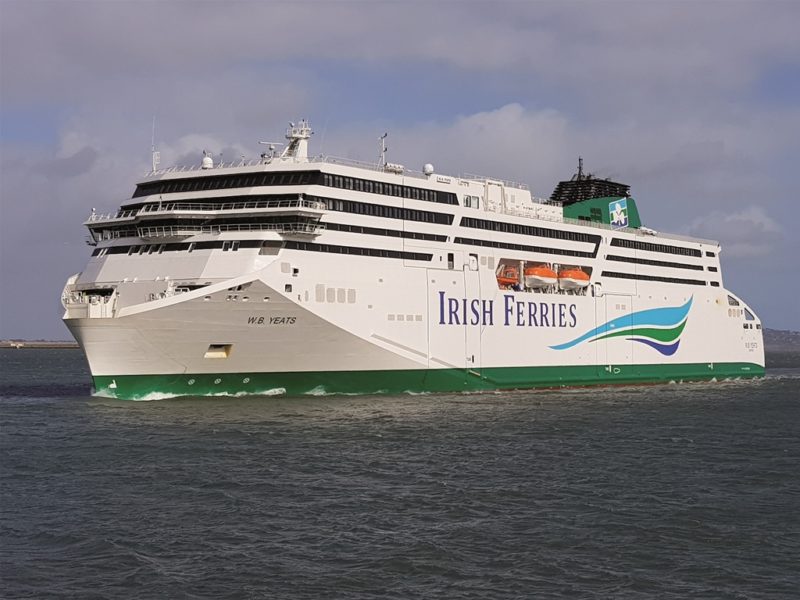
B. + I. IN POST-WAR YEARS
The cattle carrier Wicklow built in 1895 and the sole survivor of the City of Dublin Steam Packet Co. Ltd. was only able to give three more years of service until broken up in 1948 after a career of 53 years. The veteran passenger ships Longford (ex Lady Connaught) and Louth (ex Lady Munster) took the Dublin to Liverpool sailings from 1946 to 1948, when two new passenger ships entered service from Harland & Wolff Ltd. at Belfast as Leinster (2) and Munster (2) of 4,115 grt with accommodation for one thousand passengers and service speeds of 17.5 knots. They were fitted with Denny Brown stabilisers, and also had spaces in the holds for cattle as this remained an important trade from Dublin to Liverpool, and had green hulls and buff upper works and had cost £700,000 each. A slightly smaller new passenger ship for the Cork to Fishguard service was delivered as Innisfallen (2) of 3,705 grt from the Denny yard at Dumbarton with accommodation for 976 passengers and was also equipped with Denny Brown stabilisers. She wore the City of Cork Steam Packet Co. Ltd. colours of a black hull andwhite funnel with a black top.
B. + I. Line in post-war years had their Head Office at North Wall House in Dublin, with the Passenger Ticket Office at Westmoreland Street in Dublin. Branch Offices were in Liverpool, Cork, Drogheda, Dundalk, Fishguard, Limerick, London, Manchester, Newry and Preston. The Chairman of the company was Capt. A. R. Stansmore Nutting, with five directors in M. Arnet Robinson, Lord Glenavy, R. D. Heard, F. C. Martin, R. W. Sinnott, and with W. H. B. McCourrey as General Manager. The longest serving member of the Board was Lord Glenavy, who at the age of 71 years had been Assistant Controller of Munitions during the Great War, and subsequently had worked in the Irish Department of the Ministry of Labour and had seen the nomenclature of B. + I. ships change from ‘Lady’ names to Irish counties in 1937/38. The loading berths of the ships were as follows:-
Dublin North Wall and Sir John Rogerson’s Quay
Liverpool Waterloo Dock, Prince’s Dock and Nelson Dock
Cork Penrose Quay
London East India Dock, Number 1 Shed
Manchester Pomona Dock
Plymouth Victoria Wharves and Millbay Pier
Fishguard Fishguard Harbour
Bristol Cumberland Basin
Cardiff Bute Dock
Southampton Town Quay
Swansea South Dock
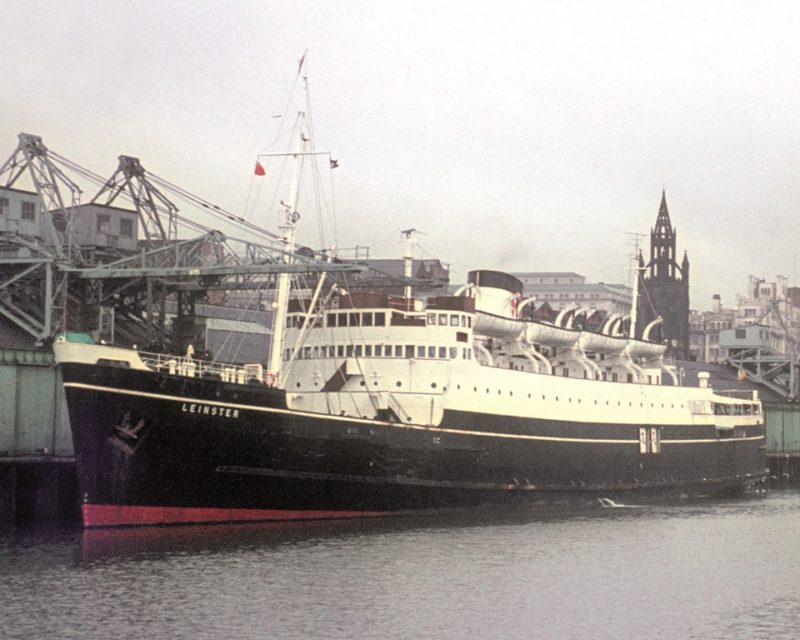
B. + I. Line and Coast Lines only belatedly began using unit load motorships and the smaller type of containers in the 1950s and 1960s, and with no ro-ro ships on their services, they ordered a new cattle carrier, launched at the Liffey Dockyard by the wife of the Irish Taoiseach on 4th November 1960 as Meath (3) of 1,590 grt to carry cattle and sheep from Dublin to Liverpool and Manchester. She gave thirteen years of service, and served alongside the older cattle carriers and cargo ships of Kilkenny, Dundalk, Inniscarra, Glengariff, Wicklow and Glanmire, with Ulster Herdsman on charter from the Belfast Steamship Co. Ltd.
By 1965, the Board of Directors of Coast Lines had come to the decision that it was time to sell the B. + I. and the subsidiary City of Cork Steam Packet Co. Ltd. to the Irish Government, as both the cattle trade and the passenger trade were declining, for which £2.75 million had been spent on new ships in post-war years. A special Acquisition Act of 18th March 1865 was signed by the Minister of Trade and Transport of the Irish Government, Erskine Childers, for the purchase of all of the 1.6 million ordinary shares of the B. + I. owned by Coast Lines. The Irish Government paid £3.606 million for the purchase or £2.25 per share, with a Chairman and seven directors to be appointed for the new company. The steps to alter the Memorandum and Articles of Association of the B. + I. were reserved in order to comply with the Companies Act of 1963. The B. + I. was now completely and truly Irish again.
Three new car ferries were ordered, with two orders going to the Nobiskrug yard at Rendsburg and one to the Verolme Cork Dockyard at Cork, taken over by Cornelius Verolme of Rotterdam in 1959. Munster, Innisfallen and Leinster of 1968/69 were of 4,850 grt with dimensions of overall length of 118.2 metres, moulded beam of 17.84 metres, and moulded depth of 11.4 metres with accommodation for 98 berthed passengers in 37 cabins and 762 unberthed passengers. The car deck took 220 cars over the stern ramp, and they had fully welded hulls with two decks and a third deck clear of the machinery spaces, and service speeds of 18.0 knots from four 18 cylinder M.A.N. diesel engines of 11,828 bhp. The time on the Liverpool to Dublin was reduced by three hours to a voyage of 8.5 hours, while Innisfallen operated on a Cork to Swansea run from May 1969.
New terminal buildings were constructed at Dublin, Liverpool and Cork in the early 1970s. B. + I. Freightway services were operating at full stretch in the mid 1970s from the B. + I. Ferryport and Freight Complex in Alexandra Road in Dublin, the B. + I. Tivoli Ferryport at Cork, the B. + I. Freight Complex in Trafalgar Dock at Liverpool, and the B. + I. Ferryport in Swansea. Unit Load services ran from Dublin to Liverpool and Weston Point, and ro-ro and groupage services ran from Dublin to Liverpool, Dublin to Le Havre and extended to Bremen and Hamburg using the new ro-ros Wicklow of 1972 and Dundalk of 1974, Cork to Swansea, Cork to Liverpool via linertrain to Dublin, Drogheda to Liverpool, and Dublin and Fleetwood to Rotterdam. Containers were carried on these routes by the company ships Kildare, Kilkenny, Tipperary and Wicklow and the chartered Nanomark.
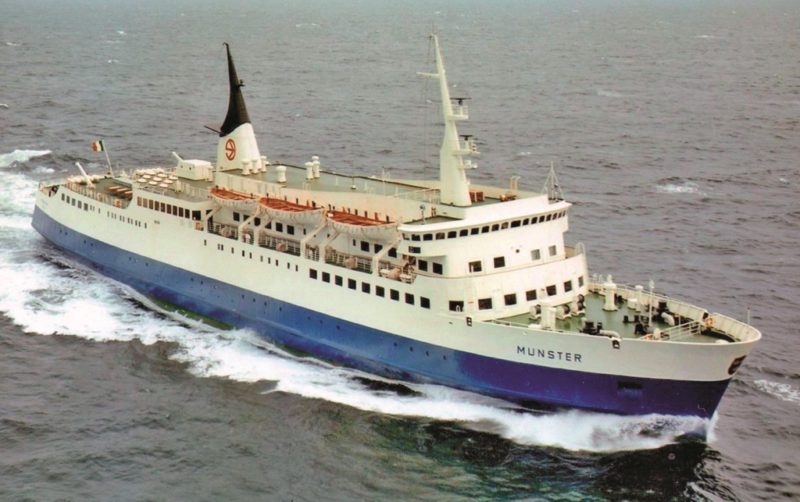
A larger passenger and car ferry named Connacht of 6,800 grt with accommodation for 1,500 passengers and 350 cars on her car deck made her maiden voyage on 22nd May 1979 on the Cork to Pembroke Dock service. She had been completed by the Verolme Cork Dockyard, with Innisfallen moved to the Dublin to Liverpool service. A service also ran from Rosslare to Pembroke Dock using chartered ferries, with Leinster switched to Cork to Pembroke Dock service and Connacht to the Dublin to Liverpool service. A new ferry and sister of Connacht was delivered as Leinster by the Verolme Cork Dockyard in July 1981 for the Dublin to Liverpool night service, the pair had dimensions of length 122.0 metres, moulded beam of 18.83 metres, and moulded depth of 12.55 metres, and were ice strengthened with three decks and one moveable deck. They had accommodation for 306 berthed passengers and 998 deck passengers, and the car deck had space for 326 cars and 40 trailers. A speed of 20 knots was obtained from four 8 cylinder MaK diesel engines of 18,000 bhp. Connacht and Leinster also maintained a new Dublin to Holyhead day service from 1982, until Connacht was sold to Brittany Ferries in 1988 and renamed Duchess Anne and then to Jadrolinja of Croatia in 1996 and renamed Dubrovnik.
Leinster was renamed Isle of Inishmore to bring in a new nomenclature to B. + I. in 1993, and Isle of Inisturk in 1996, before being sold to the Government of Canada in 1997 and renamed Madeleine.
On 25th April 1980 a jetfoil service from Dublin to Liverpool was begun by Cuna Mara (Sea Dog) by B. + I. but was soon withdrawn as the Irish Sea was too rough for this specialised type of craft. The company had financial problems in 1981, with Innisfallen then running from both Cork and Rosslare to Pembroke Dock to save money, and a new service was begun from Dublin to Holyhead, a Sealink port, with crews of both ferry companies sadly blocking the paths of the opposition ferries in and out of the port. The Cork to Pembroke Dock service was closed at the end of 1983, but losses continued to mount and the company agreed to share routes and resources with Sealink in 1985. The Welsh port of the Rosslare service was moved from Pembroke Dock to Fishguard in 1986, with Innisfallen running alongside St. Brendan. Labour disputes with the officers of the ferries lasted six weeks, and with the end of the agreement with Sealink in 1987, together with the sad ending of the Dublin to Liverpool service on 6th January 1988, the Irish Government decided to sell B. + I., and bids were invited from Irish Continental Line, P. & O. Ferries and Maersk Line in 1990. Irish Continental Line won and took over B. + I. on 1st January 1992.
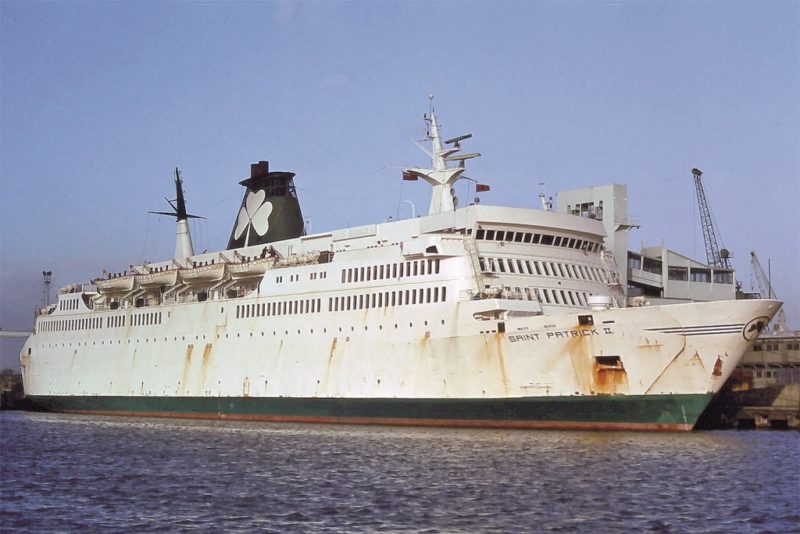
IRISH CONTINENTAL LINE
The well known Southampton to Le Havre night ferries Dragon and Leopard of Normandy Ferries were switched in 1968 to a service from Rosslare to Le Havre operated by General Steam Navigation Co. Ltd., SAGA of France, and Irish Shipping Ltd. (ISL) as managers and ticket sellers. ISL had begun to operate in 1941 with the purchase of fifteen elderly tramp steamers to carry foodstuffs into Ireland in wartime. The supply of ships on the open purchase market was almost non existent at this time, and tramps were purchased in very bad condition, with one ship under repair for the whole of the war. In post-war years, ISL built up a modern fleet of cargo ships and bulk carriers, and then branched out into liner shipping in 1968. This joint service to France was withdrawn at the end of the 1971 service.
Irish Continental Line was formed in 1973 by Lion Ferry A/B of Sweden and Fearnley & Eger of Norway with ISL again as managers and ticket sellers for a new service from Rosslare to Le Havre. A new ferry was completed in 1973 by the Schichau Unterweser yard at Bremerhaven as Saint Patrick of 5,285 grt and had a successful summer season. The funnel colours adopted were green for Ireland, blue for Sweden and white for Norway, with an Irish three leafed white shamrock later used on a green band from 1978. The service became a two ship service in April 1978 when the ferry Stena Scandinavica of 7,125 grt was purchased and renamed Saint Killian, later renamed Saint Killian II.
Saint Patrick was transferred to the newly formed Belfast Car Ferries in 1982 and renamed Saint Columb and then Saint Colum I, after the ending of the Belfast Steamship Co. Ltd. service to Liverpool in November 1981. She was an early morning arrival at Liverpool on her run from Belfast when seen from my hotel window of the Royal Hotel, built as a Georgian hotel in 1815 to celebrate the victory over Napoleon Bonaparte at the Battle of Waterloo. The hotel has views over the Mersey approach channel from the Waterloo suburb of Liverpool, while I was working on contract to the Girobank headquarters in Liverpool. She was replaced by a ferry renamed as Saint Patrick II, the former Finnish ferry Aurella of 7,210 grt with berth capacity increased to 450 passengers for her new service.
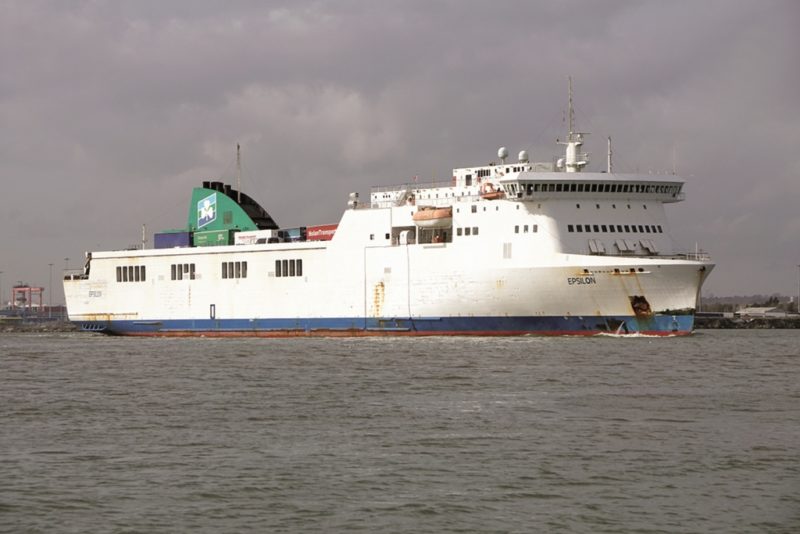
Irish Continental Line took over B. + I. on 1st January 1992 and chartered the big ferry Stena Nautica with accommodation for 1,840 passengers and the ability to take 410 cars on her car deck for the Rosslare to Le Havre route, and renamed as Isle of Innisfree. An order was then placed with the Van der Giessen yard at Krimpen in Holland for an owned ferry of 22,365 grt for delivery in 1995 to replace the chartered ferry and take her name. Irish Continental Line have used the operating name of Irish Ferries from 1995, replacing the famous name of B. + I., with white hulls and ‘IRISH FERRIES’ emblazoned in dark blue on both sides of the hull during the later 1990s for Isle of Innisfree and the newer Isle of Inishmore of 34,031 grt, delivered in 1997 with accommodation for 2,200 passengers and space for 800 cars and 122 trucks on her car deck.
The fast craft Jonathan Swift with a very good turn of speed of 37 knots was placed in 1999 on the Dublin to Holyhead service with accommodation for 800 passengers and space for 200 cars on her car deck. She was powered by a four water jet propulsion system and was very successful with passengers travelling from or to London and other cities via Holyhead harbour, and was replaced in April 2020 by the similar fast craft Dublin Swift. Irish Ferries then operated four services in Dublin to Holyhead, Rosslare to Pembroke Dock, Rosslare to Cherbourg, and Rosslare to Roscoff.
The new big ferry Ulysses of 50,938 grt was completed in February 2001 by Aker Finnyards O/Y at Rauma and had accommodation for 1,875 passengers with 1,647 unberthed and 228 berthed, and space on her car decks for 1,342 cars and 300 trucks accessed via one bow ramp and two stern ramps. She has an overall length of 209.08 metres, moulded beam of 31.84 metres and a depth of 9.9 metres. and her four 9 cylinder MaK diesel engines deliver a massive 42,416 bhp of power to give a service speed of 23 knots.
Irish Ferries as from 27th April 2020 have a fleet of four passenger and car ferries and one fast ferry in service, these are:-
Dublin Swift, a fast ferry built in 2001 by Austal Ltd. at Henderson (Western Australia) on the Dublin to Holyhead service replacing fast ferry Jonathan Swift in April 2020 with accommodation for 820 passengers on airline type seats and 220 cars on her car deck. She can operate at an economical speed of 20 knots or as a fast ferry at 33 knots. Jonathan Swift (1667-1745) was named after the writer and satirist who was born in Dublin to English parents. He crossed to England in 1688 to take Church of England orders but instead of practising he became active in politics and the literary world. He retired to Ireland ten years later as Dean of St. Patrick’s, and wrote his most famous work of Gulliver’s Travels in 1726.
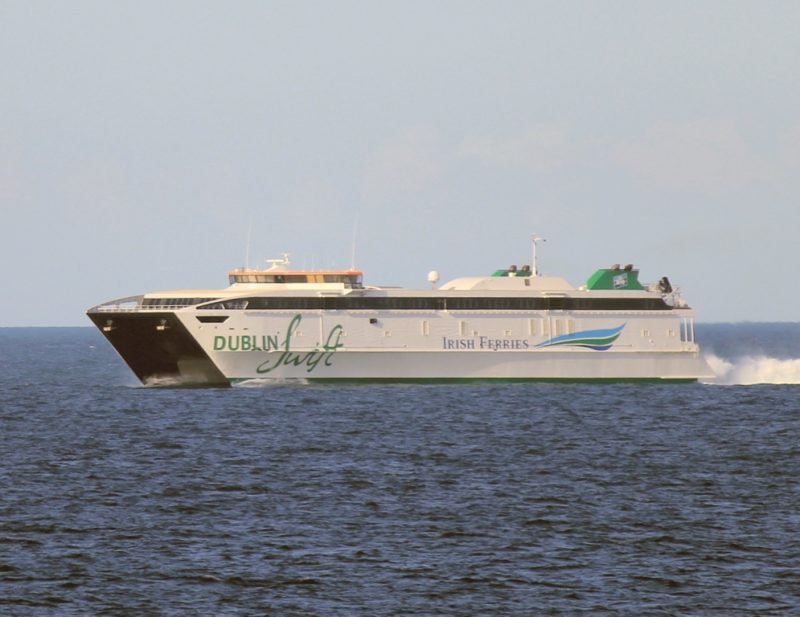
Ulysses is named after the work by author James Joyce (1882-1941) who was born in Dublin, with the book Ulysses being about a day in the life of two Irishmen. The ferry serves on the Dublin to Holyhead route, and has a Promenade Deck, Cinema that doubles as a Theatre, a Family Entertainment Centre, a Balcony Lounge as well as shops, cafes, bars and restaurants.
Epsilon is a ‘Visentini’ type passenger ro-ro on the Dublin to Holyhead route, with a Saturday run from Dublin to Cherbourg. She has been on charter from Cartour Srl of Bari since 2013 and was completed in 2011. She is of 26,375 grt with a service speed of 24 knots from twin M.A.N. – B. & W. diesel engines and twin controllable pitch propellers.
Isle of Inishmore of 34,031 grt has served on the Rosslare to Pembroke Dock service and other routes since her delivery to Irish Ferries in 1997.
W.B. Yeats is named after William Butler Yeats (1865-1939) born near Dublin and a leader of the Irish literary revival movement as a lyric poet and playwright. The ferry is the same size as Ulysses and of 51,388 grt and was launched on 19th January 2018 by Flensburger Schiffs and completed on 22nd January 2019. She has accommodation for 1,800 passengers and 85 crew, either unberthed or in 440 cabins with some luxury suites over four passenger decks. She has an overall length of 195.0 metres and a moulded beam of 31.6 metres, and a service speed of 22.5 knots and is powered by four MaK diesel engines of 45,400 bhp driving controllable pitch propellers.
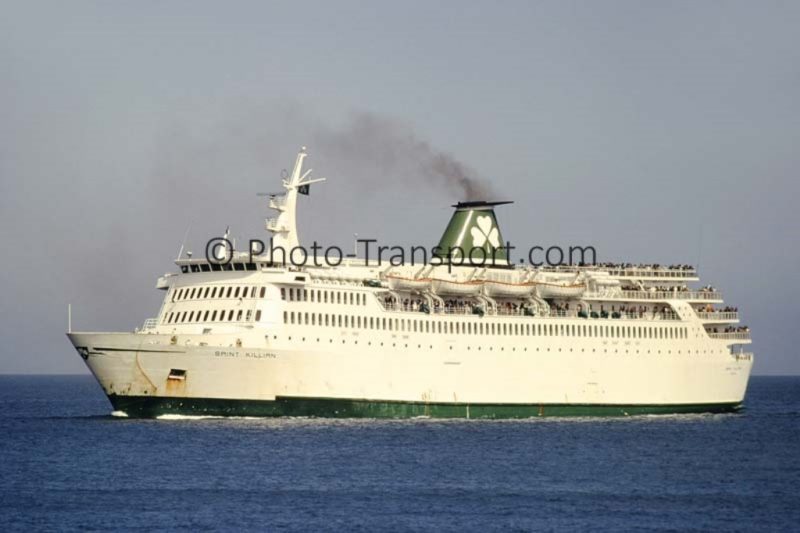
POSTSCRIPT
The B. + I. had a very long history from 1836 to 1995 in Dublin, with offices and several buildings on the North Wall Quay including a Cartage and Motor Haulage Department, and a yard with a building that bore the name of B. + I. in large letters at its top and was demolished in the 1990s to make way for the offices of Citibank. Fortunately, their former premises on Sir John Rogerson’s Quay are still a protected structure in 2020. The Cartage and Motor Haulage Department was set up in 1920 to replace horses for the collection and delivery of goods from its steamers, although a few horses were kept on for several decades. Steamers had sailed from Dublin as early as 1815, and it is very pleasing that Irish Ferries are continuing this success story from Dublin in 2020, over 200 years later.
Irish Ferries today transports many hundreds of thousands of travellers per annum between Dublin and Holyhead in comfort in modern public lounges on their two very large passenger and car ferries, Ulysses and W. B. Yeats. They both received water cannon receptions from fire tugs when arriving for their maiden voyages at Dublin in early 2001 and early 2019, akin to Transatlantic liners arriving at New York for the first time. This pair are huge ferries of length over 600 feet with good turns of speed. Businessmen and those requiring a much faster passage on the route have for the last 20 years used the fast crafts Jonathan Swift and Dublin Swift.

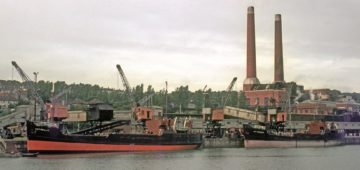


Comments
Sorry, comments are closed for this item